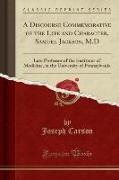Read more
Excerpt from A Discourse Commemorative of the Life and Character, Samuel Jackson, M.D: Late Professor of the Institutes of Medicine, in the University of Pennsylvania
A Faithful record of the lives of men who have borne a prominent part in the affairs of the world, who have been remarkable not only for their eminence in professional pursuits, but for the length of time that they have engaged in them, is of twofold interest.
Such a record not only exhibits to us the steps by which individual success and reputation have been attained; but it is interwoven with the history of the times through which they passed. It entails a narrative of events of general concern, of changes which have exercised an important influence upon the progress of mankind, and of improvements and discoveries which have contributed to the expansion and perfection of positive knowledge. From these alone, when estimated in their fulness, the evidence can be drawn of the advances made by generation upon generation in the march of science and of civilization.
It will be the purpose of the present effort to thus sketch the life of the eminent physician and teacher, who, for so long a period, was conspicuous before his fellow-men as a promoter of professional advancement, and who was especially distinguished as an ornament and sustainer of this school of medicine.
Dr. Samuel Jackson was born in the city of Philadelphia, on March 22d, 1787. He was the son of Dr. David Jackson of Chester County, Penna., who was one of the first class of graduates on whom the degree of Bachelor of Medicine was conferred by the College of Philadelphia in 1768, and subsequently a Trustee of the Institution. His mother was Susan Kemper, the daughter of Jacob Kemper, who came to this country from Germany in 1741, and settled in New Jersey.
About the Publisher
Forgotten Books publishes hundreds of thousands of rare and classic books. Find more at www.forgottenbooks.com
This book is a reproduction of an important historical work. Forgotten Books uses state-of-the-art technology to digitally reconstruct the work, preserving the original format whilst repairing imperfections present in the aged copy. In rare cases, an imperfection in the original, such as a blemish or missing page, may be replicated in our edition. We do, however, repair the vast majority of imperfections successfully; any imperfections that remain are intentionally left to preserve the state of such historical works.

